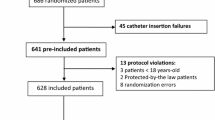Abstract
Objective
The purpose of the study was do describe the architecture of accretions occurring on the tips of central venous catheters (CVC).
Design
A conservative procedure was used followed by two different techniques of electron microscopy
Setting and patients
the study included 19 catheters which have been used on intensive cared adults, and which were chosen among those of parallel 300 CVC study.
Measurements and results
CVC were considered sterile, contaminated, colonized or infected according to microbiological and clinical criteria. CVC were found to remain much cleaner than in past clescriptions. When present, accretions were located on the olive-shaped end, and displayed stratified structures with three types of material: amorphous material, thrombus components and inflammatory cells. Bacteria were not seen, even on culture positive CVC.
Candida albicans was found on one CVC in the cytoplasm of ganulocytes, and made xio direct contact with the plastic surface.
Conclusion
This technique should contribute to the understanding of the pathobiology of CVC infection and provide information proving or precluding the involvement of microbial adherence to polymers in vivo.
Similar content being viewed by others
References
Marrie TJ, Costerton JW (1984) Scaunning and trasmission electron microscopy of in situ bacterial colonization of intravenous and intraarterial catheters. J Clin Microbiol 19:687–693
Passerini L, Phang PT, Jackson FL, Lam K, Costerton JW, Cing EG (1987) Biofilms on right heart flow-directed catheters. Chest 92:440–446
Poisson DM, Touquet S, Bercault N, Arbeille B (1991) Polyurethanne versus Polyethylene: étude and randomisée in vivo des complications infectieuses du catheterisme central. Pathol Biol (Paris) 39:668–673
Maki DG, Weise CE, Sarafin HW (1977) A semiquantitative, culture method for identifying intravenous catheter-related infection. N Engl J Med 296:1305–1309
Brun-Buisson C, Abrouk F, Legrand P, Huet Y, Larabi S, Rapin M (1987) Diagnosis of central venous catheter-related sepsis. Arch Intern Med 147:873–877
Bourassa MG, Cantin M, Sandborn EB, Pederson E (1976) Scanning electron microscopy of surface irregularities and thrombogenesis of polyurethane and polyethylene coronary catheters. Circulation 53:992–996
Peters G (1984) Untersuchungen zur Pathogenese, der Staphylokokkeninfektion von Kunststoffimplantaten und intravasalen Kathetern. Infection 12:235–239
Franson TR, Sheth NK, Rose HD, Sohnle P (1984) Scanning electron microscopy of bacteria adherent to intravascular catheters. J Clin Microbiol 20:500–505
Cooper GL, Hopkins CC (1985) Rapid diagnosis of intravascular catheter-associated infection by direct Gram staining of catheter segments. N Engl J Med 312:1142–1147
Zufferey J, Rime B, Francioli P, Bille J (1988) Simple method for rapid diagnosis of catheter-associated infection by direct acridine orange staining of catheter tips. J Clin Microbiol 26:175–177
Messing B, Peitra-Cohen S, Debure A, Beliah M, Bernier JJ (1988) Antibiotic.-lock technique: a new approach to optimal therapy for catheter-related sepsis in home parenteral nutrition patients. J Parenter Enteral Nutr 12:185–189
Sitges-Serra A, Linares J, Garau J (1984) Catheter sepsis: the clue is the hub. Surgery 97:355–357
Flowers RH, Schwenzer KJ, Kopel RF, Fisch MJ (1989) Efficacy of an attachable subcutaneous cuff for the prevention of intravascular catheter-related infection. JAMA 261:878–883
Bjornson HS, Colley PDR, Bower RH, Duty VP, Schwartz-Fulton JT, Fisher MSN, Fisher JE (1982) Association between microorganism growth at the catheter insertion site and colonization of the catheter in patients receiving total parenteral nutrition. Surgery 92:720–727
Poisson DM, Arbeille B, Laugier J (1991) Electron microscopic studies of endotracheal tubes used in neonates. Res Microbiol 142:1019–1027
Coper GL, Schiller AL, Hopkins CC (1988) Possible role of capillary action in pathogenesis of experimental catheter-associated dermal tunnel infection. J Clin Microbiol 26:8–12
Dougherty SH (1988) Pathobiology of infection in prosthetic devices. Rev Infect Dis 10:1102–1117
Author information
Authors and Affiliations
Rights and permissions
About this article
Cite this article
Poisson, D.M., Touquet, S., Bercault, N. et al. Electron-microscopic description of accretions occurring on tips of infected and non-infected central venous catheters. Intensive Care Med 18, 464–468 (1992). https://doi.org/10.1007/BF01708582
Received:
Accepted:
Issue Date:
DOI: https://doi.org/10.1007/BF01708582




